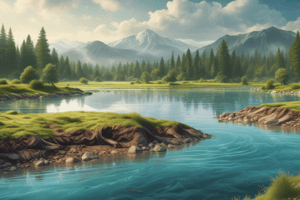Podcast
Questions and Answers
¿Cuál de las siguientes categorías no corresponde a la clasificación del agua?
¿Cuál de las siguientes categorías no corresponde a la clasificación del agua?
- Agua criogénica
- Agua dulce
- Agua salina (correct)
- Agua atmosférica
¿Qué problema relacionado con el agua es más crítico en Perú?
¿Qué problema relacionado con el agua es más crítico en Perú?
- Desastre hídrico por inundaciones
- Suministro excesivo de agua potable
- Contaminación por metales pesados (correct)
- Escasez de agua debido a la desforestación
Las vertientes de agua pueden clasificarse según su origen. ¿Cuál de las siguientes opciones describe mejor una vertiente exógena?
Las vertientes de agua pueden clasificarse según su origen. ¿Cuál de las siguientes opciones describe mejor una vertiente exógena?
- Derivadas de glaciares y núcleos polares
- Vienen de fuentes subterráneas
- Provenientes de precipitaciones (correct)
- Resultado de la actividad tectónica
Las aguas lenticas se caracterizan por:
Las aguas lenticas se caracterizan por:
¿Cuál de las siguientes afirmaciones sobre las aguas loticas es correcta?
¿Cuál de las siguientes afirmaciones sobre las aguas loticas es correcta?
Flashcards
Aguas lóticas
Aguas lóticas
Cuerpos de agua en movimiento, como ríos y arroyos.
Aguas lénticas
Aguas lénticas
Cuerpos de agua estancada, como lagos y estanques.
Aguas criogénicas
Aguas criogénicas
Agua en estado sólido, como hielo o glaciares.
Problemas del agua en Perú
Problemas del agua en Perú
Signup and view all the flashcards
Vertientes
Vertientes
Signup and view all the flashcards
Study Notes
Classification of Water
-
Lotic Waters: These are flowing water bodies such as rivers, streams, and creeks. They are characterized by constant movement of water.
-
Lentic Waters: These are still or standing water bodies like lakes, ponds, and reservoirs. They exhibit little to no current.
-
Cryogenic Waters: These are water bodies that exist in or are influenced by cryosphere (permanent ice and snow). Glacial meltwater, permafrost, and snowmelt systems are examples.
-
Atmospheric Water: Water in the atmosphere, including water vapor, clouds, and precipitation (rain, snow, hail). This type of water is crucial for the hydrological cycle.
Problems Affecting Water in Peru
-
Deforestation and Land-Use Change: Reduced forest cover leads to increased soil erosion and sedimentation in water bodies, impacting water quality and quantity.
-
Agricultural Practices: Increased fertilizer and pesticide use can contaminate water sources with harmful chemicals, affecting aquatic life and human health. Improper irrigation methods can lead to water depletion, particularly in arid areas.
-
Mining Activities: Improper mining practices can contaminate water with heavy metals and other hazardous substances, leading to water pollution.
-
Industrial Discharge: Wastes from industries, including manufacturing and processing plants, can pollute waterways with various harmful substances, endangering ecosystems.
-
Urbanization and Sewage: Increased urbanization and inefficient sewage systems contribute significantly to water pollution, releasing untreated or inadequately treated waste into water bodies.
-
Climate Change: Changing precipitation patterns, glacier melt, and rising temperatures can disrupt water quantity and quality, affecting ecosystems and water resources.
-
Lack of Access to Sanitation: Poor sanitation infrastructure and practices contribute to water-borne diseases and water contamination.
-
Over-extraction of Groundwater: Excessive pumping of groundwater can lead to depletion of aquifers and land subsidence.
-
Lack of Awareness and Education: Insufficient awareness about water conservation and best practices can worsen problems related to water management and pollution.
Water Basins (Vertients) of Peru
-
Amazon River Basin: This is one of the largest river basins globally and covers a significant portion of Peru, supporting vast biodiversity and impacting numerous communities. Water resources here are vital for agriculture, industry, and ecosystem services.
-
Pacific Ocean Drainage: This includes river systems that drain towards the Pacific Ocean. These basins often face challenges related to water scarcity, particularly during dry seasons.
-
Lake Titicaca Basin: The basin of Lake Titicaca, in the Andes, presents specific water management concerns due to its high altitude, unique ecosystem, and competing demands for water resources.
-
Other Andean River Systems: Numerous smaller river systems in the Andes Mountains contribute to Peru's water resources, presenting similar challenges and potential for improved management strategies. Specific details concerning individual river systems would depend upon the particular river system in question.
Studying That Suits You
Use AI to generate personalized quizzes and flashcards to suit your learning preferences.




